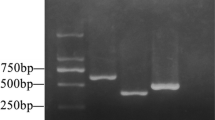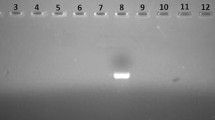Abstract
Escherichia coli O157:H7 is well known enterohemorrhagic pathogen responsible for infections among animals including a man. The main source of this bacterium is cattle, that is mostly asymptomatic and through that E. coli O157:H7 can simple transfer to food products. Therefore, there is a need for rapid, sensitive and specific detection method. The present work is focused on its detection by a heptaplex polymerase chain reaction, which targets genes from known virulent regions of E. coli O157:H7. According to obtained results this approach is able to reach the detection sensitivity of 4 colony-forming units (CFU) from a culture and 6 and 8 CFU from milk and meat samples, respectively, independently of tested sample volume.
Similar content being viewed by others
Abbreviations
- CFU:
-
colony-forming units
- EHEC:
-
enterohemorrhagic E. coli
- LB:
-
Luria-Bertani broth
- PBS:
-
phosphate buffered saline
- PCR:
-
polymerase chain reaction
- SMAC:
-
sorbitol MacConkey agar
- Stx:
-
shiga-like toxin
References
Beebakhee G., Louie M., De Azavedo J. & Brunton J. 1992. Cloning and nucleotide sequence of the eae gene homologue from enterohemorrhagic Escherichia coli serotype O157:H7. FEMS Microbiol. Lett. 91: 63–68.
Boerlin P., McEwen S.A., Boerlin-Petzold F., Wilson J.B., Johnson R.P. & Gyles C.L. 1999. Associations between virulence factors of shiga toxin-producing Escherichia coli and disease in humans. J. Clin. Microbiol. 37: 497–503.
Brunder W., Schmidt H. & Karch H. 1997. EspP, a novel extracellular serine protease of enterohaemorrhagic Escherichia coli O157:H7 cleaves human coagulation factor V. Mol. Microbiol. 24: 767–778.
Chotár M., Vidová B. & Godány A. 2006. Development of specific and rapid detection of bacterial pathogens in dairy products by PCR. Folia Microbiol. 51: 639–646.
Dziva F., Mahajan A., Cameron P., Currie C., McKendrick I.J., Wallis T.S., Smith D.G.E. & Stevens M.P. 2007. EspP, a type V-secreted serine protease of enterohaemorrhagic Escherichia coli O157:H7, influences intestinal colonization of calves and adherence to bovine primary intestinal epithelial cells. FEMS Microbiol. Lett. 271: 258–264.
Gannon V.P.J., D’souza S., Graham T., King R.K., Rahn K. & Read S. 1997. Use of the flagellar H7 gene as a target in multiplex PCR assays and improved specificity in identification of enterohemorrhagic Escherichia coli strains. J. Clin. Microbiol. 35: 656–662.
Gannon V.P.J., Rashed M., King R. K. & Thomas E.J.G. 1993. Detection and characterization of the eae gene of shiga-like toxin-producing Escherichia coli using polymerase chain reaction. J. Clin. Microbiol. 31: 1268–1274.
Jacewicz M.S., Acheson D.W.K., Binion D.G., West G.A., Lincicome L.L., Fiocchi C. & Keusch G.T. 1999. Responses of human intestinal microvascular endothelial cells to shiga toxins 1 and 2 and pathogenesis of hemorrhagic colitis. Infect. Immun. 67: 1439–1444.
Jothikumar N. & Griffiths M.W. 2002. Rapid detection of Escherichia coli O157:H7 with multiplex real-time PCR assays. Appl. Environ. Microbiol. 68: 3169–3171.
Kaper J.B., Nataro J.P. & Mobley H.L.T. 2004. Pathogenic Escherichia coli. Nature Rev. Microbiol. 2: 123–140.
Li R., Harada T., Honjoh K.I. & Miyamoto T. 2010. Phylogenetic analysis and Shiga toxin production profiling of Shiga toxin-producing/enterohemorrhagic Escherichia coli clinical isolates. Microb. Pathog. 49: 246–251.
Lim J.Y., Yoon J.W. & Hovde C.J. 2010. A brief overview of Escherichia coli O157:H7 and its plasmid O157. J. Microbiol. Biotechnol. 20: 1–10.
Michino H., Araki K., Minami S., Takaya S., Sakai N., Miyazaki M., Akio O. & Yanagawa H. 1999. Massive outbreak of Escherichia coli O157:H7 infection in school children in Sakai city, Japan, associated with consumption of white radish sprouts. Am. J. Epidemiol. 150: 787–796.
Rangel J.M., Sparling P.H., Crowe C., Griffin P.M. & Swerdlow D.L. 2005. Epidemiology of Escherichia coli O157:H7 outbreaks, United States, 1982–2002. Emerg. Infect. Dis. 11: 603–609.
Schmidt H., Scheef J., Huppertz H.I., Frosch M. & Karch H. 1999. Escherichia coli O157:H7 and O157:H — strains that do not produce shiga toxin: phenotypic and genetic characterization of isolates associated with diarrhea and hemolyticuremic syndrome. J. Clin. Microbiol. 37: 3491–3496.
Si C., Kun-Lun H., Wen-Tao X., Yuan L. & Yun-Bo L. 2007. Real-time quantitative PCR detection of Escherichia coli O157:H7. Chin. J. Agric. Biotechnol. 4: 15–19.
Thompson J.S., Hodge D.S. & Borczyk A.A. 1990. Rapid biochemical test to identify verocytotoxin-positive strains of Escherichia coli serotype O157. J. Clin. Microbiol. 28: 2165–2168.
Author information
Authors and Affiliations
Corresponding author
Rights and permissions
About this article
Cite this article
Vidová, B., Tóthová, E., Blahut, Ľ. et al. Multiplex PCR for detection of Escherichia coli O157:H7 in foods. Biologia 66, 401–405 (2011). https://doi.org/10.2478/s11756-011-0052-z
Received:
Accepted:
Published:
Issue Date:
DOI: https://doi.org/10.2478/s11756-011-0052-z




